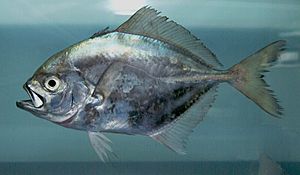Cottonmouth jack facts for kids
Quick facts for kids Cottonmouth jack |
|
|---|---|
 |
|
| Conservation status | |
| Scientific classification | |
| Synonyms | |
|
The cottonmouth jack (Uraspis secunda) is a type of gamefish. It belongs to the Carangidae family. This family includes many kinds of jacks and trevally.
A Cuban zoologist named Felipe Poey first described this fish in 1860. He wrote about it in his book, "Natural History of the Island of Cuba." People also call this fish the cottonmouth trevally.
What the Cottonmouth Jack Looks Like
Adult cottonmouth jacks are usually dark in color. Young cottonmouth jacks, called juveniles, are pale. They have six or seven brown stripes along their sides.
These fish get their name "cottonmouth" from their unique mouth. Their mouth and tongue are a bright, bleach-white color. This helps tell them apart from other fish in their family.
The cottonmouth jack has two main fins on its back. The first dorsal fin has nine stiff spines. The second dorsal fin has twenty-seven to thirty-two soft rays. Its anal fin has three spines and nineteen to twenty-three soft rays.
The longest cottonmouth jack ever found was about 50 cm (20 inches) long. The heaviest one weighed about 2.04 kg (4.5 pounds).
Where the Cottonmouth Jack Lives
The cottonmouth jack lives in the open ocean. This means it swims in the middle or upper layers of the water. You can find them at depths from 1 to 36 m (3 to 118 ft).
They live in many different oceans around the world.
- In the western Indian Ocean, they are found near the coast of Tanzania.
- In the eastern Pacific Ocean, they live from California down to Costa Rica and around Hawaii.
- In the western Atlantic, you can find them from Massachusetts all the way to Brazil. They also live in the northern Gulf of Mexico.
- In the eastern Atlantic, cottonmouth jacks are found from Mauritania to Angola. They have also been seen off the western coast of South Africa.
Cottonmouth jacks usually swim throughout the water column. Sometimes, they are seen feeding near the bottom, especially around islands. They are not very common. You usually see them alone or in small groups.
-
A Cottonmouth jack caught off Key West.
-
Another from off the coast of Sri Lanka.
-
From the waters near Fiji.
See Also
 In Spanish: Uraspis secunda para niños
In Spanish: Uraspis secunda para niños




